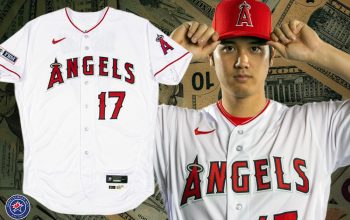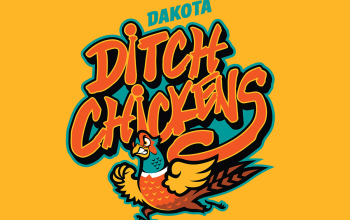 In a March 2001 episode of The Simpsons, Homer Simpson staged a nine-day hunger strike to thwart plans by Springfield Isotopes owner Howard K. Duff VIII (of Duff Beer fame) to move the local baseball team to Albuquerque, New Mexico. The ordeal ended with Homer victorious, standing on the outfield grass being showered with food by grateful fans for exposing the threat. It seemed it was safe to believe that the dystopian future pictured here was never meant to be.
In a March 2001 episode of The Simpsons, Homer Simpson staged a nine-day hunger strike to thwart plans by Springfield Isotopes owner Howard K. Duff VIII (of Duff Beer fame) to move the local baseball team to Albuquerque, New Mexico. The ordeal ended with Homer victorious, standing on the outfield grass being showered with food by grateful fans for exposing the threat. It seemed it was safe to believe that the dystopian future pictured here was never meant to be.
But just two years later, Homer’s worst nightmare came to fruition in real life when the Florida Marlins’ new triple-A affiliate, the Albuquerque Isotopes, debuted in New Mexico. (They’re a Dodgers affiliate now.) Even worse for Homer, it seems that the move from Springfield to Albuquerque has paid off, because according to Forbes magazine, the real-life Isotopes are the fourth-most valuable franchise in minor league baseball. In a game that I attended this season, the team set an attendance record with 16,348 fans—more than a few Major League teams get on certain nights.
 Before the Isotopes, Albuquerque was home to a number of different teams dating back to 1915, many of them called the Dukes, including a triple-A Pacific Coast League team that played there from 1972 to 2000. That team left Albuquerque to become one of roughly a million different minor league teams that have been the Portland Beavers.
Before the Isotopes, Albuquerque was home to a number of different teams dating back to 1915, many of them called the Dukes, including a triple-A Pacific Coast League team that played there from 1972 to 2000. That team left Albuquerque to become one of roughly a million different minor league teams that have been the Portland Beavers.
The franchise that brought baseball back to Albuquerque in 2003 had been the Calgary Cannons since 1985 and before that, the Salt Lake Gulls from 1971 to 1984. When the franchise held a name-the-team contest after moving to Albuquerque, the final vote included five options, including the Dukes. The Simpsons episode (“Hungry Hungry Homer,” season 12, episode 15) was still fresh in the imaginations of fans and Isotopes won convincingly, receiving more than half the tally. So the baseball team approached the TV show about using the name.
There is no formal relationship between the baseball team and the TV show, but the team’s logo type looks very Simpsons-y, the stadium plays host to statues of characters from the TV show, and Ken Levine, who wrote the Simpsons episode in question, threw out the first pitch at a game last season and was interviewed by the team about the name.
“We don’t sell any Simpsons-type things in our pro shop or anything like that, so it’s not gone that far,” said Laura Verillo, the Isotopes’ director of public relations through the end of last season. (She has since moved on to a position with the New York Mets.) “But there is an agreement to an extent that we can use the Albuquerque Isotopes name that was in that episode.”
While the Simpsons connection is the overwhelming reason behind the nickname, there’s more to the Isotopes than that. “The area that we are in is a big scientific area,” Verillo said. “We have the Sandia Labs over here, so that’s part of it—the science background on it.” (Sandia National Laboratories, according to Wikipedia, are “two major United States Department of Energy research and development national laboratories.”)
 Not only that, but one particularly famous high school science teacher and chemist, pictured here in an Isotopes hat, once lived in Albuquerque and supported the team, evidently.
Not only that, but one particularly famous high school science teacher and chemist, pictured here in an Isotopes hat, once lived in Albuquerque and supported the team, evidently.
This connection to science poses a unique challenge to the team’s employees. “We get the question, What is an isotope to begin with?” Verillo said. “Our staff has to know some chemistry, and I don’t think you really have that with any other Major or minor league teams.”
 The Isotopes have achieved what minor league baseball teams everywhere strive for. Their merchandise sells across the USA and internationally, and not just because Dodger fans want to support their highest-level minor league franchise. Sometimes it’s scientists who like the actual image of something scientific on a hat, and sometimes it’s Dodgers pitcher Brian Wilson who wants to wear something snazzy under his Major League uniform.
The Isotopes have achieved what minor league baseball teams everywhere strive for. Their merchandise sells across the USA and internationally, and not just because Dodger fans want to support their highest-level minor league franchise. Sometimes it’s scientists who like the actual image of something scientific on a hat, and sometimes it’s Dodgers pitcher Brian Wilson who wants to wear something snazzy under his Major League uniform.
“It’s not just for baseball fans,” Verillo said. “I think people are attracted to the uniqueness of our logo. It’s not your typical animal mascot.”
The Isotopes logo is definitely not typical. It’s the only one I know of that is based on a 13-year-old episode of a kids’ TV show and that features baseball-shaped neutrons circling the nucleus of an atom in a pattern that forms a capital A. In a way, the team lucked into a great situation (every city should have a wildly popular cultural reference to name their new team after), and it’s very much to their credit that they took advantage of the opportunity that was presented to them.














